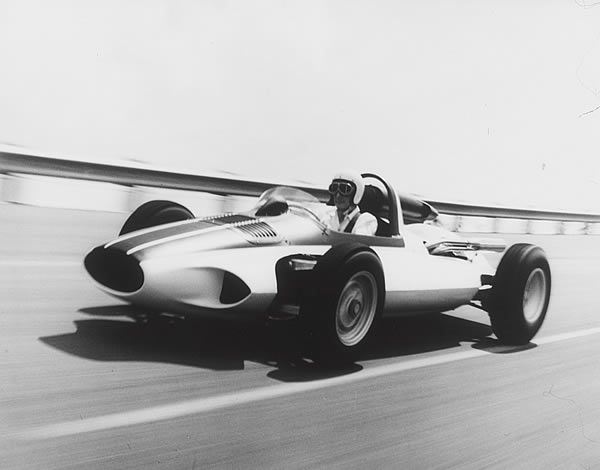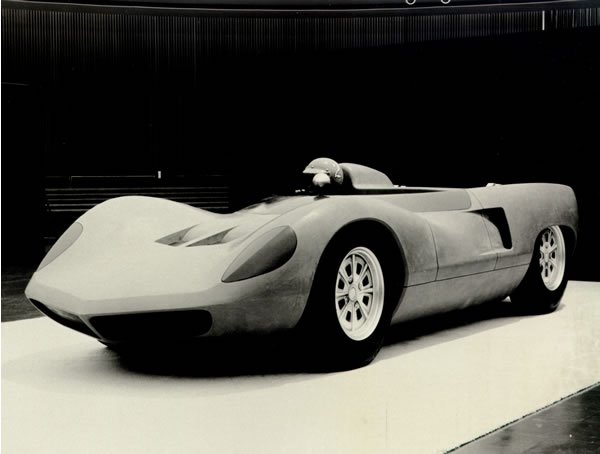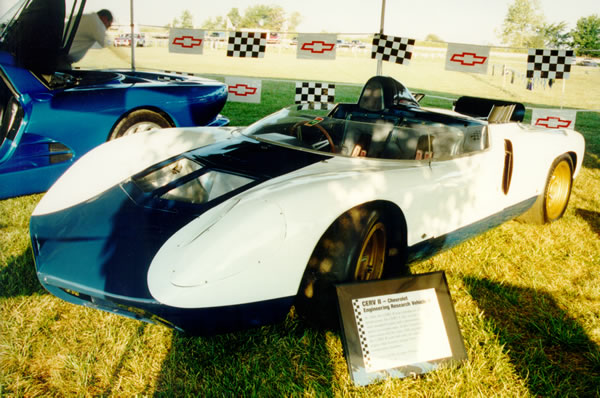CERV II Corvette: Interview with Larry Shinoda
Cerv II: Interview with Larry Shinoda
© Wayne Ellwood, 1995
Used here with permission by the author
 |
 |
 |
 |
 |
You might recall that when we were talking about Grand Sport II(b) I mentioned that it was often confused with CERV II, even by people inside GM. I have to repeat that the GS II (b) was a research project started by Frank Winchell and was entirely separate from CERV II which was Zora's car.
There is a visual similarity in some areas, of course. This is unavoidable since some of the same design people, like myself and Tony Lapine, worked on both cars and they were undertaken in about the same time period. A lot of the cues are common to that era but the mission statements and design philosophies behind the two are so entirely different that it's hard to believe that people still confuse the two.
Let me first recap the purpose of the CERV nomenclature. CERV stood for Chevrolet Engineering Research Vehicle. CERV I was developed between 1959-60 by Zora Arkus Duntov as a functional open-wheeled race car. Now I did the design of both of these cars so I know where some of the technical specification came from, but there's a lot of the fine detail where I have to rely on previously published articles and stuff that I have taken from other sources. But, as I understand the history, CERV I was first tested by Zora when he personally drove it in the Pike's Peak hillclimb. The car had a chrome-moly steel tube chassis welded in a truss-like configuration and weighed only 125 pounds. The wheelbase was 96 inches and the whole car weighed only 1600 pounds wet. The fuel injected small block technology was developed using this car. The car is now privately owned but (at the time of Zora's tribute) it was on display at the National Corvette Museum.
CERV II was also built under Zora's direction between 1963-64. Zora had it in mind to develop a separate line of racing Corvettes but the idea got squashed by management, even though Zora had Bunkie's support. Anyway, Zora got one car built and he packed it with the technologies he thought would make a good race car. Wally Wyss has written a lot about this car (KEEPING TRACK, July 1984) so, if you look at his material, you will understand that it was conceived to be much more than was ever realized after the management decision.
The CERV II was conceived early in 1962 and developed over the next year, after the GS program was also squashed. The chassis wasn't the same as the GS II(b) though. It was more like the Ford GT-40. It was a monocoque with steel subframe to carry the suspension and engine. The original power plant was the 377 cubic inch aluminum small block. Cross ram 58 mm Weber carburetors and a 10.8 compression ratio were planned but I think they finally settled on the Hilborn fuel injection. Power output would have been in the 500 range. I don't know how long that engine lasted but in its latter days the car was fitted with a big block. Karl Ludvigsen reported on a drive he had in the car (Motor Trend, November, 1970) when it apparently had a ZL-1 style all aluminum engine. I don't know if that one stayed with the car, either.
There is very little doubt, however, that the two main features of the car were the four wheel drive and the new Firestone tires.
The engineering of the drive system and torque converter arrangement was handed over to GM's engineering staff and the team was headed-up by Raymond Michnay, according to Ludvigsen's material. This was the first time that anyone had tried to design a variable power delivery to each end of the car, and which would vary according to vehicle speeds. I guess they succeeded because depending on the gearing, it was reported that the car would do 0-60 in 2.5 seconds or over 180 MPH while still achieving 0-60 in under 5 seconds.
The articles I have seen describe this arrangement as using an 11 inch Powerglide torque converter off the rear of the engine for the rear drive. It was modified so that it wouldn't reach lock-up (1:1 ratio) until about 4500 RPM. At the front there was a 10 inch Powerglide converter from a Corvair (placed ahead of the front wheels as per Corvair's rear arrangement). This one would approach lock-up at around 4100 RPM. Zora specified a two-speed gearbox for each end of the car, placed behind the final drive gears. These gave a choice of direct drive or a 1.5 to one reduction.
The brakes for the CERV were mounted outboard in the normal manner. The Girling calipers were widened to accept a vented rotor. The hub carriers (front and rear) were cast nodular iron with the front steering arms being forged steel. This is all very normal to the Corvette. Concentric coil springs and Armstrong shock absorbers were used at all four corners.
The car first rolled on the Milford test track in March 1964. It was somewhat later in the year that GM decided it really didn't want Zora proceeding with a car to challenge FORD at LeMans and put the lid on the program. In that period, however, several important drivers of the day, including Jim Hall and Roger Penske, had a chance to drive it. After that, Bob Clift got to play with it for a while. I think he did most of the "tire testing" and it was in this period that the ZL-1 style big block was added. It was at this time that the vertical exhaust stacks were added for simplicity, too. I won't pretend to know if this is correct, so you'll have to chase that one down with engineering.
The tires were Firestones just like the ones that Mickey Thompson used that year at INDY. They were experimental tires and measured 9.2 X 15 and were mounted on 9.5 X 15 Kelsey-Hayes magnesium wheels. The wheels were larger than most cars of the time and could theoretically be enlarged to an 11 inch width. The wheel was a knock-off design. The tires were the same size front and rear, since the four wheel drive was supposed to deliver just about equal power delivery to each wheel, depending on the loading.
Now, there are only a few points that have been previously written that I can comment on. First, some of the articles of the time indicated that this car was variously designated as the GS-3 and later as GS-10. I don't know anything about this; it seems to me that this might be as much a "pr" creation as anything else. Although if it works for the Corvette community, I guess it just adds to the mystique.
